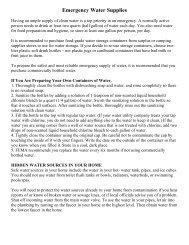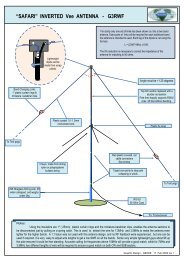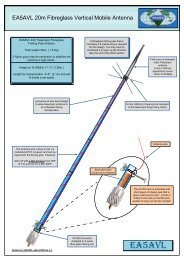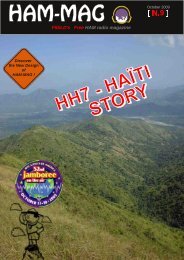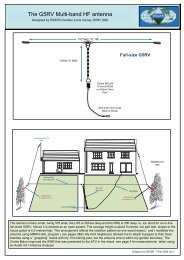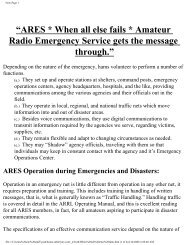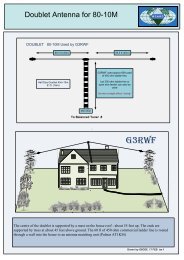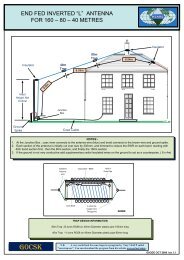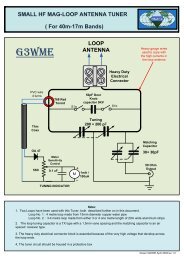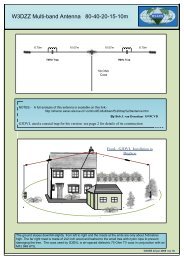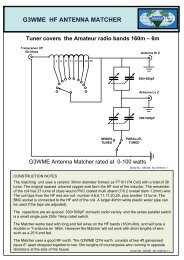A Small Yagi for 50 MHz - ONZ.be
A Small Yagi for 50 MHz - ONZ.be
A Small Yagi for 50 MHz - ONZ.be
- No tags were found...
You also want an ePaper? Increase the reach of your titles
YUMPU automatically turns print PDFs into web optimized ePapers that Google loves.
6 Meters—The Early YearsA personal history by Dave, W3BJGHaving just read the “6 Metre Handbook” by Don Field, G3XTT, I realized that although this book wasintended as a handbook, I felt that there was a lot of 6 meter background in<strong>for</strong>mation not addressed.I <strong>be</strong>came licensed as WN3BJG in February of 1955. This was <strong>be</strong><strong>for</strong>e the days of FM and Repeatersand EME, Moonbounce, Scatter and all of the other technologies available today was essentiallybuzzwords but there were a few pioneers.. SSB was just coming into <strong>be</strong>ing as far as the amateur world.For the average Ham, It was either A1 or A3 emissions. A new word was spreading among the amateurworldsemiconductors! To most, this was a Selenium rectifier, others were experimenting withGermanium diodes and a few lucky ones gained access to the Raytheon CK722 transistor.I immediately got on the air on the utilizing the 2 Meter band, mainly <strong>be</strong>cause I had previously acquireda surplus SCR522 rig which was completely converted and ready to go on the air.Having no HF transmitting capability, I spent my entire Novice year operating on the 2M band andlistening to W1AW and private code practice stations, getting ready to go <strong>for</strong> the General class license,which I successfully obtained within the one year grace period.Not many commercial manufactures were making <strong>50</strong> <strong>MHz</strong>equipment in the mid <strong>50</strong>'s. Practically all commercial/amateurequipment manufactured at the time only went to 30 <strong>MHz</strong>. As Irecall, I got on the air after much prodding by my friends on 144<strong>MHz</strong>. A recently <strong>for</strong>med VHF Club had as a club project, a <strong>50</strong><strong>MHz</strong> transmitter so I built it and then I needed a receiver. Havingplayed with some superregenerative receivers <strong>be</strong><strong>for</strong>e getting mylicense, I took that route and finally had a <strong>50</strong> <strong>MHz</strong> station.A quick check thru the advertisers in the ARRL Handbooks yielded the following manufacturers of <strong>50</strong><strong>MHz</strong> gear: See Appendix 1.According to my Log Book, my first 6M contact was February 12, 1956 but this activity ceased in April ofthe same year when I enlisted in the Navy. In June of 1956, I bought my first piece of commercial2M equipment, a Gonset Communicator.As I recall, my first piece of 6M equipment, was a Tapetone XC<strong>50</strong> Double Cascode High Per<strong>for</strong>mance6M converter which Ibought early in1957 and used it in conjunction with a BC312Nsurplus receiver. Ithink my 6M antenna at the time was most likely a modified TV antenna.During the next several years, while I was attending Navy TechnicalSchools I did manage to operatefrom Memphis, W4ODR and later when stationed in Hawaii, KH6AHQ. Most of the operation at theseclubs was on the HF bands, handling phone patch traffic.During the latter part of 1956 and early 1957, I had the opportunity to<strong>be</strong>come acquainted with PaulWilson, W4HHK. I often visited withhim while he was at work as a TV engineer at a local television inMemphis, TN and also was <strong>for</strong>tunate in visiting him at his home QTHin Collierville, TN. One of thethings I remem<strong>be</strong>r most about hisstation were the twin towers he had erected in preparation <strong>for</strong> theupcoming IGY program, See QST, Nov. 1957. On these towers Paul had erected 6M arrays and thetowers were oriented so in one direction, they pointed directly towards W1AW and in the oppositedirection, they were directed towards Australia.[ HAMMAG N.12 January 2010 ]



